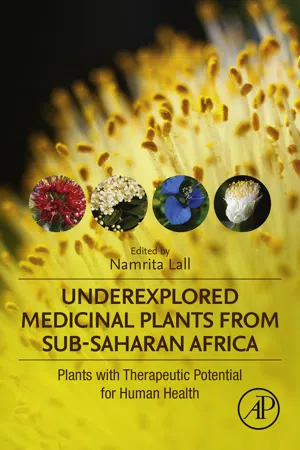
Underexplored Medicinal Plants from Sub-Saharan Africa
Plants with Therapeutic Potential for Human Health
- 358 pages
- English
- ePUB (mobile friendly)
- Available on iOS & Android
Underexplored Medicinal Plants from Sub-Saharan Africa
Plants with Therapeutic Potential for Human Health
About This Book
Underexplored Medicinal Plants from Sub-Saharan Africa: Plants with Therapeutic Potential for Human Health examines a comprehensive selection of rarely explored plants that have been underestimated for their therapeutic value. The book contains monographs of medicinal plants, outlining their botanical description, geographical distribution, ethnobotanical usage, chemical constituents, sample and standard preparations and methods, and pharmacological properties. With expert contributors from South Africa, Mauritius, Seychelles, Cameroon and Nigeria, and the compilation of ethnobotanical, taxonomic and pharmacologic information for each species, this book is a valuable resource for researchers, academics in pharmacology, ethnopharmacology, medicinal plant sciences, and more.
- Explores the therapeutic potential of a comprehensive selection of underexplored and underutilized medicinal plants in sub-Sahara Africa
- Provides a summary table of structures of any known natural products, including details of plant source (chapter) and observed activity (e.g. anticancer, antibacterial)
- Includes contributions from experts from South African, Mauritius, Seychelles, Cameroon and Nigeria
Frequently asked questions
Information
Acalypha integrifolia Willd
Abstract
Keywords

1. General description
1.1. Botanical nomenclature
1.2. Botanical family
1.3. Vernacular names
2. Botanical description
3. Distribution
4. Ethnobotanical usage
5. Phytochemical constituents
6. TLC fingerprinting of plant extracts
Table of contents
- Cover image
- Title page
- Table of Contents
- Copyright
- Disclaimer
- Contributors
- About the editor
- Foreword
- Introduction
- Chapter 1. Acalypha integrifolia Willd
- Chapter 2. Aloe lomatophylloides
- Chapter 3. Aloe macra
- Chapter 4. Aloe purpurea
- Chapter 5. Aloe spicata
- Chapter 6. Aloe tormentorii
- Chapter 7. Bauhinia galpinii
- Chapter 8. Bruguiera gymnorhiza
- Chapter 9. Buddleja saligna
- Chapter 10. Combretum molle
- Chapter 11. Commelina benghalensis
- Chapter 12. Elaeodendron transvaalense
- Chapter 13. Equisetum ramosissimum
- Chapter 14. Eriosema kraussianum
- Chapter 15. Erythrophleum lasianthum
- Chapter 16. Euclea natalensis
- Chapter 17. Eugenia crassipetala
- Chapter 18. Eugenia tinifolia
- Chapter 19. Ficus glumosa
- Chapter 20. Ficus lutea
- Chapter 21. Ficus sur
- Chapter 22. Greyia radlkoferi
- Chapter 23. Haemanthus albiflos
- Chapter 24. Heteropyxis canescens
- Chapter 25. Heteropyxis dehniae
- Chapter 26. Hypericum revolutum subsp. revolutum
- Chapter 27. Juncus effusus
- Chapter 28. Lannea schweinfurthii
- Chapter 29. Lippia scaberrima
- Chapter 30. Newtonia buchananii
- Chapter 31. Nymphaea caerulea
- Chapter 32. Ocimum labiatum
- Chapter 33. Phyllanthus phillyreifolius
- Chapter 34. Plantago longissima
- Chapter 35. Plectranthus ecklonii
- Chapter 36. Plectranthus neochilus
- Chapter 37. Rapanea melanophloeos
- Chapter 38. Ravenala madagascariensis
- Chapter 39. Searsia lancea
- Chapter 40. Siphonochilus aethiopicus
- Chapter 41. Stillingia lineata subsp. lineata
- Chapter 42. Terminalia bentzoe subsp. bentzoe
- Chapter 43. Terminalia prunioides
- Chapter 44. Vigna unguiculata
- Chapter 45. Wikstroemia indica
- Chapter 46. Zantedeschia aethiopica
- Index